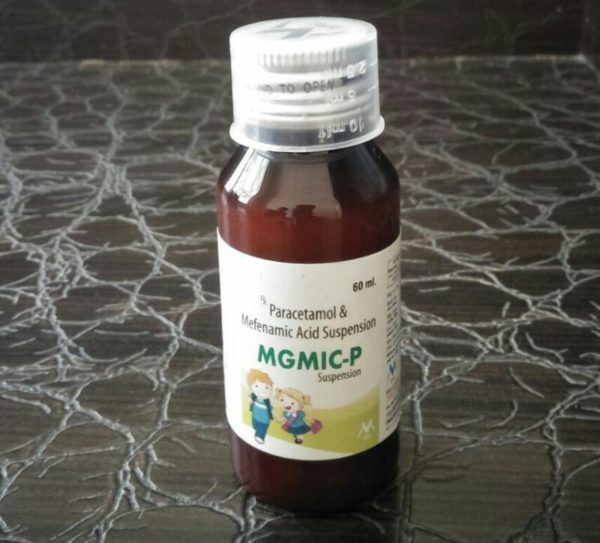MGMIC-P
COMPOSITION : PARACETAMOL 125 MG + MEFENAMIC ACID 50 MG
- Reviews (0)
- Indication
- Description
Be the first to review “MGMIC-P”
Mefenamic acid plus Paracetamol suspension is licensed for use in children and it is available in specific paediatric formulations (oral liquids). It is indicated for pain and fever in children. This formulation is used as an antipyretic as well as analgesic. Main features: Fever, Muscle Pain, Sciatica.
Mefenamic acid plus paracetamol suspension is a highly useful combination for the treatment of moderate. Pains connected with rheumatoid arthritis. Paracetarnol is one of the most popular non-prescriptive analgesics, antipyretic drug. Mefenamic acid is a non-steroidal anti-inflammatory agent with analgesic properties, and a demonstrable antipyretic effect. It is licensed as an anti-inflammatory analgesic for the symptomatic relief of rheumatoid arthritis, osteoarthritis and pain including muscular, dental pain, headaches and pyrexia in children. The medicine is available in oral suspension formulation for the paediatrics population.
It has been demonstrated by recent studies from International Journal of Medical Research & Health Sciences studies of Mefenamic Acid, paracetamol shows better symptom relief compared with other formulations.
Pharmacology
Pharmacokinetics
Mefenamic Acid:
Absorption: oral absorption of mefenamic acid is found to be 92.5%.
Distribution: volume of distribution is found to be 1.3 l/kg and plasma protein binding is 99%.
Metabolism: metabolism is reported Hepatic via enzyme CYP2C9.
Excretion: renal excretion accounts for 70% and plasma half life is 3-4 hr.
Paracetamol:
Absorption: oral absorbed from the gastrointestinal tract ranging from 70 to 90%. Paracetamol is also well absorbed from the rectum.
Distribution: It distributes rapidly and evenly throughout most tissues and fluids and has a volume of distribution of approximately 0.9L/kg. 10 to 20% of the drug is bound to red blood cells.
Metabolism: Paracetamol is extensively metabolized (predominantly in the liver), the major metabolites being the sulphate and glucuronide conjugates.
Excretion: A minor fraction of drug is converted to a highly reactive alkylating metabolite and excreted in the urine as cysteine and mercapturic acid conjugates.
Interaction
BEFORE TAKING THIS MEDICINE TELL THE DOCTOR ABOUT ANY MEDICAL PROBLEMS AND ALLERGIES THAT A CHILD HAS OR HAD.
Mefenamic acid:
Mefenamic Acid enhances activity of oral anticoagulants but rarely significant. Increases risk of GI irritation with alcohol. Increased ciclosporin, lithium toxicity and convulsions reported with ciprofloxacin. Absorption increased by magnesium hydroxide antacids. ACE inhibitor effects may be antagonized.
Paracetamol:
Absorption of paracetamol is increased by concomitant metoclopramide, and such other agents. Probenecid can decrease it’s clearance whilst cholestyramine diminishes absorption of paracetamol when co administered.
Side Effects
The most commonly reported adverse effects are:
Feeling or being sick
Hypersensitivity reactions
Skin rashes
Diarrhea
Nausea
Contraindications
This suspension is not advocated for those allergic to its ingredients and in acute severe liver dysfunction.
“Response to medications may vary from one individual to another, contain side effects like (dizziness, vomits) that have been reported very rarely with the medicine may affect some patient’s ability to drive, operate machinery.”






Reviews
There are no reviews yet.